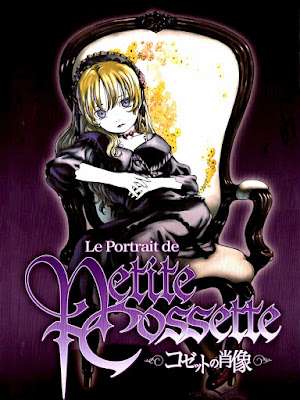Studio: Daume
Director: Akiyuki Simbo
Screenplay: Mayori Sekijima
Tell Cast: Marina Inoue as
Cossette d’Auvergne; Mitsuki Saiga as Eiri Kurahashi; Kumiko Yokote as Hatsumi
Mataki; Megumi Toyoguchi as Shouko Mataki; Rei Igarashi as Zenshinni of
Shakado; Ikumi Fujiwara as Michiru Yajiri; Isao Yamagishi as Hiroshi Hakuta;
Junpei Morita as Yukata Enokido; Mamiko Noto as Yuu Saiga; Masashi Ebara as
Marchello Orlando; Shinnosuke Furumoto as Michio Hisamoto; Susumu Chiba as
Naoki Katou; Yukari Tamura as Kaori Nishimoto
Considered in Eastern in English Subtitles
Eiri Kurahashi is the lead of a
one-off panic myth about objects, at the side of a painting, of the daughter of a
French family which is imprinted with her soul, a phenomenal younger lady named
Cossette who he encounters first in his job at an antique retailer with a Venetian
wine glass that starts to lift forth visions of her. Cossette was murdered by
an Italian painter who grew to change into engaging about her magnificence, following the premise of
how her soul or a receive of her, especially after her annoying loss of life, has left
her ghost in several objects acquired and introduced to Japan centuries later. This
is a mission, notably, from Akiyuki Simbo,
is silent early in his profession, in context that he had already directed a host of
straight-to-video boom and tv series, but sooner than he made a constructive
diagram of initiatives that caught on in a huge capacity. For certain, when work like Puella Magi Madoka Magica (2011) was
turning into insanely smartly-liked, people would occupy not neglected him, and you look here
already with Le Portrait…. the
model and heightened melodrama that he would lift to that production. Assorted
titles of this period, even when of different genres, just like the surreal college
comedy Paniponi Rush! (2005), confirmed
his obsession with the form of his work, but this exhibits him bringing forth
this surrealism with the panic model.
The myth, despite the indisputable truth that spoil up into
three under forty minute episodes, works totally in the structure of a
theatrical movie, where after a blood pact Kurahashi takes the poisoned soul of
the painter into himself, prepared to change into the sacrificial guinea pig to bleed
and purge every of the cursed objects connected to her loss of life. This does occupy a
melodramatic facet extra overall, in how it’s depicted, in anime equivalent to how he
transforms steady into a monster when the painter’s receive takes over, and one of the easiest ways
attempting to purge the curse objects, at the side of the are attempting by one of the women
surrounding him attempting to support him, outcomes in magical noise and energy blasts.
It is always nonetheless, in premise, a myth you derive in gothic literature and
cinema, of turning into obsessed and falling in like with someone who is previous the
grave, summary, an obsession with this like which robs him of his connection to
truth. It is a timeless myth, retold here, as a quartet of women in his original
existence, at the side of one who is smitten for him, are attempting to support someone who has
fallen in like with a ghost and the recollections he inherits of her.
Here’s over-the-high, where
someone will actually paint in their occupy blood for the dramatic 2d, but
returning to this production, even as a pure model fragment this sounds like a nice
production for panic anime by the utilization of unrestrained imagination and mood. As
someone who gets a kick out of the trope in anime of figure entering
phantastical worlds between realities, customarily an eighties and nineties trope,
here is stuffed with such scenes, a feast of the eyes despite the indisputable truth that the strains of early
pc effects are infrequently seen. Huge dolls, hundreds of sentient
floating eyes, and a discipline where the residing and dead can co-exist, in-built the
image of Cossette, which is both of a Gothic landmass, with so many a entire bunch of
lit candles inner, and has flesh walls with objects falling off. It is a
cavalcade of stylistic tropes introduced alongside with studio Daume, who produced their occupy work moreover in-between animation,
most intriguing to sadly not attain powerful into the 2010s onwards. As an customary premise,
barring a manga tie-in between episodes, here is the form of production which
must be praised for its are attempting at creativity, at the side of moments in the main
episode bleeding time and discipline to depict Kurahashi’s disconnect from truth
that receive a mode of in dreadful health-ease.
Returning to this, even with
song which conjures up the utilization of the band Kalafina
for Madoka, I look many of the
gothic and panic fine that seeped into that production, a model for the
aesthetical in magnificence matched with deeply macabre storytelling. After all,
adding to the curiosity and rate of this production as its occupy myth, Le Portrait… depict torture and has
gash blood loss, but will not be a piece of gristly loss of life but tragedy. Here’s a
intriguing turn because the myth progresses, turning steady into a psychodrama about our male
lead attempting to address this like previous his mortal truth he is embroiled in,
and one of the easiest ways it in a roundabout procedure turns into in regards to the distinction between an particular person and their
image, actually an antagonist by the end of this. It is, for its over-the-high
tone, pure romantic panic drama and in actuality stands out.

.jpg)
%20a.jpg)
%20b.jpg)